The Gospel Unifies Diverse People, Cultures, Elder Rasband Says at Durban South Africa Temple Dedication
Contributed By Scott Taylor, Church News managing editor

Elder Ronald A. Rasband of the Quorum of the Twelve Apostles talks with attendees during the cornerstone ceremony for the Durban South Africa Temple dedication in Umhlanga, South Africa, on Sunday, February 16, 2020. Photo by Jeffrey D. Allred, Deseret News.
Durban South Africa Temple facts
Address: 2 Izinga Drive, Izinga Ridge, 4021 Umhlanga, KwaZulu-Natal, South Africa
Announced: October 1, 2011
Groundbreaking: April 9, 2016, by Elder Carl B. Cook of the Seventy
Completed: November 14, 2019
Open house: January 22 through February 1, 2020
Dedicated: February 16, 2020, by Elder Ronald A. Rasband of the Quorum of the Twelve Apostles
Project managers: Alan Rudolph and Anton Fourie
Architects: Brian Everett NWL and Sagnelli: Paton Taylor JV
Contractor: Stefcon Projects
Civil engineer: Arup (Pty) Ltd.
Landscape architect: Uys & White Landscape Architects
Property size: 14.49 acres
Landscape area: 13.59 acres
Temple size: 1,845 square meters (19,860 square feet)
Building height: 29.7 meters, including angel Moroni statue (97.5 feet)
Temple district: The South African provinces of KwaZulu-Natal and Eastern Cape and the countries of Lesotho and Mozambique
Related Links
DURBAN, South Africa
Diversity dominated the scene of engaging smiles, hearty handshakes, warm embraces, and shared selfies as the throngs of Latter-day Saints gathered outside the Durban South Africa Temple before, during, and after its three dedicatory sessions on Sunday, February 16.
Vibrant hues featured on the dresses, blouses, and ties accented the dark suits and white shirts. Skin colors spanned the spectrum from whites to browns to blacks. Language ranged from English and some Portuguese to the clicks and stops of Xhosa, Zulu, and other tribal languages.
All of this represents the diverse Durban temple district in South Africa, Lesotho, and Mozambique. All represent a blended, growing Latter-day Saint family in South Africa and neighboring nations. And all are representative of God’s sons and daughters.
“The Church has a great way of minimizing those differences and creating a gospel culture separate to these traditions and separate to these ethnicities,” said Elder Ronald A. Rasband of the Quorum of the Twelve Apostles, who presided and spoke at the three dedication sessions and offered the dedicatory prayer.
“What you saw outside was how the doctrines of the gospel of Jesus Christ unite us, and I felt very at one as a people today. Regardless of how they look, regardless of how they dressed, we were one people today—the people of the Church of Jesus Christ.”
Dedicating South Africa’s Second Temple
With the dedication—including the public-facing cornerstone ceremony at the start of the first session—the Durban temple becomes the Church’s 168th operating temple worldwide and the 5th on the African continent.

Elder Ronald A. Rasband assists Siseko Phungunla with mortar during the cornerstone ceremony for the Durban South Africa Temple dedication in Umhlanga, South Africa, on Sunday, February 16, 2020. Photo by Jeffrey D. Allred, Deseret News.
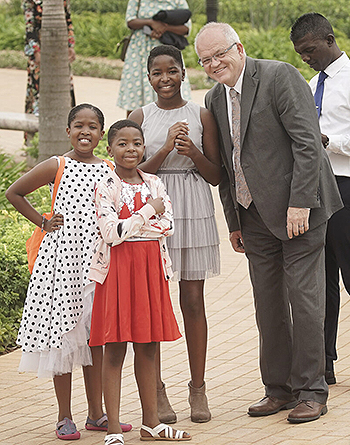
Church News managing editor Scott Taylor poses with Vuyo Tyukwana, Monica Makhatini, and Iya Makhatini outside the Durban South Africa Temple prior to its dedication in Umhlanga, South Africa, on Sunday, February 16, 2020. Photo by Jeffrey D. Allred, Deseret News.

Laura Udobong smiles while waiting in line for the Durban South Africa Temple dedication in Umhlanga, South Africa, on Sunday, February 16, 2020. Photo by Jeffrey D. Allred, Deseret News.
For the 10 days prior to the dedication, Elder Rasband and his wife, Sister Melanie Rasband, had been speaking with the members, missionaries, youth, and friends of the Church in the temple district—including two pairs of kings and queens, of Lesotho and the Zulu nation.
“And even though I’ve been with two kings, today I had the strong impression that we were here to worship and honor the King of kings,” said Elder Rasband, calling that impression “truly the benediction to our trip.”
Sister Rasband said a highlight for her was having children and grandchildren join them in the temple and being reminded that “families are forever.”
“The music has just lifted us to greater heights of spirituality as we sat and felt the Spirit grow and grow in every song,” she added. “And to be able to shout ‘Hosanna’ to the Lord and to our Father in Heaven in gratitude was just a perfect combination of our feelings.”
Elder Carl B. Cook of the Presidency of the Seventy, who with Sister Lynette Cook joined the Rasbands on their travels throughout South Africa and Lesotho, emphasized the virtues and values of the area’s Latter-day Saints.
“We appreciate the light in the eyes of the African people. We love how they live and work in families and communities. We are lifted by their genuine smiles and happiness, by their faith in God, and their gratitude for the restored gospel of Jesus Christ. We are inspired by their goodness. We learn so much from them.”
To see Latter-day Saints of all races today share embraces, let alone share common spaces as they did Sunday on the temple grounds, is a far cry from the latter half of the 20th century in South Africa, when racial segregation, known as apartheid, raged with distrust, anger, and even violence between the country’s whites and blacks, as well as between black tribal nations.
Percy “Chappy” Winstanley, who presided over the first Durban stake created in 1981 and came up from Johannesburg to attend the Durban dedication, recalled Church members putting their lives on the line regularly—sometimes in helping with routine meetings and activities.
“We had a high councilman down in the Eastern Cape who would have to run the gauntlet of rioters throwing rocks at his car to go open the meetinghouse in the morning,” he said. “Then he would have to go back [to lock the building], and here came the rocks again.”
Worries of a possible civil war overshadowed life locally 35 years ago, when the Johannesburg South Africa Temple was dedicated in 1985.
“I believe with all my heart that the Lord put a temple in Johannesburg to help apartheid come down,” said Colin Bricknell, a former bishop and stake president in Durban who last year concluded a three-year service with his wife, Jennifer Bricknell, as president and matron of the Johannesburg South Africa Temple. Their son Brad Bricknell chaired the Durban temple’s open house and dedication committee.

Colin Bricknell and his wife, Jennifer, talk about the new Durban South Africa Temple in Umhlanga, South Africa, on February 14, 2020. Photo by Jeffrey D. Allred, Deseret News.
Growth of the Saints
The Johannesburg temple is seen by Latter-day Saints as a precursor to South Africa’s changes in the decade after the temple’s dedication—including a revised constitution, the abolishment of apartheid, a racial reconciliation, and peace. They liken it to the Freiberg Germany Temple, which operated behind the Iron Curtain several years prior to the fall of the Berlin Wall and communism in Central and Eastern Europe.
“The temple has meant a lot not just to the members but also to South Africa as a whole,” Colin Bricknell said, noting that shared dressing rooms for patrons when the Johannesburg temple opened was contrary to apartheid’s norms of segregation.
And now South Africa has an additional temple—a second witness of the gospel and of the Church’s growth and stability in the nation, as well as an increased opportunity to bless the lives of Latter-day Saints.
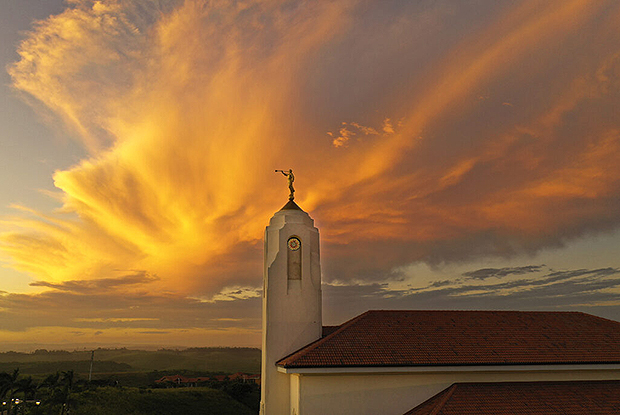
The sun sets on the Durban South Africa Temple in Umhlanga, South Africa, on February 13, 2020. Photo by Jeffrey D. Allred, Deseret News.
For decades, temple attendance for not just Durban Saints but also all South African members seemed like a long-distance challenge. Initially, “going to the temple” was a 9,000-kilometer flight (5,600 miles) to the nearest temple—in England. Later, South Africa was assigned to the district of an announced temple in São Paulo, Brazil—also in the southern half of the globe but still nearly 7,500 kilometers (4,350 miles) and a whole hemisphere away.
In the 1970s, the Bricknells had saved enough money to take their family to the temple to be sealed. But when Church leaders asked for donations from South African members to help fund the building of the São Paulo temple, the family sacrificed their travel savings.
“We contributed all we had saved for that family trip,” said Jennifer Bricknell. “And within a year, we had the money to take all five of our children to the Salt Lake Temple.”
Even with Africa’s first temple located in Johannesburg, members in the Durban area needed to travel the seven to eight hours by bus or car, making regular temple worship difficult. Often, young couples held a premarriage reception in Durban early in the morning, then rushed to Johannesburg to be sealed in the temple later that day to meet the Church’s same-day policy at the time.
Young people from Durban and the surrounding areas would serve full-time missions and come home as changed individuals, Colin Bricknell said. But they would return home—often as the only member of their family—and find it hard to get to the Johannesburg temple frequently, if at all, and then start to drift away from activity. The Durban temple now offers an additional holy place for worship, strength, and stability.

Nomfundo Kunene smiles while waiting in line for the Durban South Africa Temple dedication in Umhlanga, South Africa, on Sunday, February 16, 2020. Photo by Jeffrey D. Allred, Deseret News.
Durban’s dedication weekend served as a homecoming for Elder and Sister Cook, who had resided in South Africa as he served five years in the Africa Southeast Area Presidency, including the last three as President. He had presided at the Durban temple’s groundbreaking on April 6, 2016.
“Four years ago, Sister Cook and I climbed the hill where the Durban temple was to be built, along with many others who attended the groundbreaking,” he recalled of the beautiful, clear day.
“There was a feeling of awe as we sat on that empty hillside. We looked out over the valley and out to the ocean and realized that in a few short years, a temple would rise up on that ground. To have the sacred privilege of returning for the dedication of the Durban temple that has been built up to the Lord is very humbling. I am filled with joy.”

Elder Ronald A. Rasband of the Quorum of the Twelve Apostles talks with attendees during the cornerstone ceremony for the Durban South Africa Temple dedication in Umhlanga, South Africa, on Sunday, February 16, 2020. Photo by Jeffrey D. Allred, Deseret News.
Another Temple, Another Reason
Joining the contingent of visiting Church leaders were the three General Authority Seventies who comprise the current Area Presidency—Elder S. Mark Palmer, Elder Joseph W. Sitati and Elder Joni L. Koch—and their wives, as well as Elder Kevin R. Duncan, a General Authority Seventy and the Temple Department’s executive director.
With a new temple at a closer proximity comes new opportunities—to worship more frequently, perform more temple work for deceased ancestors, and serve more regularly as an ordinance worker or temple volunteer.
“For the members, it’s something they have to learn and understand—that the temple is a place where you worship and go regularly to, where you have the opportunity to renew your covenants,” said Winstanley. “They have to learn that process as we did in Johannesburg—that going to the temple is not a once-off visit but a constant worship and serving process.”

The choir sings during the cornerstone ceremony of the Durban South Africa Temple dedication in Umhlanga, South Africa, on Sunday, February 16, 2020. Photo by Jeffrey D. Allred, Deseret News.
Said Elder Cook: “I thrill to think of the people who will fill the temple—working, serving, and furthering the Lord’s work here on the earth and for those on the other side of the veil. It is a great blessing for the people here, as well as for each of us who rejoices in this temple. Our lives will never be the same.”
Bricknell, Winstanley, and others anticipate the Durban temple to not only provide blessings and opportunities for individuals and families but somehow to have an influence for good over the people and the land—similar to how the Johannesburg temple and the promises and blessings uttered by President Gordon B. Hinckley at its dedication are seen as having helped usher in reconciliation and peace in South Africa.
Perhaps a second temple will help sustain Church members as they seek enhanced education and employment opportunities through BYU–Pathway Worldwide or the Church’s self-reliance programs or help ease the nation’s economic hardships or help prepare the people in some other way, Bricknell said.
“It’s another temple and another reason. The Lord is in control of His timing—the ‘divine design’ that Elder Rasband talks about,” he said. “What temples have done for our people in South Africa—as well as the Church and the gospel—is to have lifted their horizons and their goals.”

A view from behind the Durban South Africa Temple on its dedication day in Umhlanga, South Africa, on Sunday, February 16, 2020. Photo by Jeffrey D. Allred, Deseret News.

Sisters Tadiwa and Tatenda Chitiyo hug outside the Durban South Africa Temple on the day of its dedication in Umhlanga, South Africa, on Sunday, February 16, 2020. Photo by Jeffrey D. Allred, Deseret News.

Iya Makhatini, Vuyo Tyukwana, and Monica Makhatini smile outside the Durban South Africa Temple on its dedication day in Umhlanga, South Africa, on Sunday, February 16, 2020. Photo by Jeffrey D. Allred, Deseret News.

Sisters Bokang and Awande Tshabalala attend the Durban South Africa Temple dedication in Umhlanga, South Africa, on Sunday, February 16, 2020. Photo by Jeffrey D. Allred, Deseret News.

Elder Ronald A. Rasband of the Quorum of the Twelve Apostles and his wife, Sister Melanie Rasband, pose with area leaders between sessions of the Durban South Africa Temple dedication in Umhlanga, South Africa, on Sunday, February 16, 2020. From left: Elder Kevin R. Duncan, Sister Gladys Sitati, Elder Joseph W. Sitati, Elder S. Mark Palmer, Sister Jacqueline Palmer, Sister Melanie Rasband, Elder Ronald A. Rasband, Elder Carl B. Cook, Sister Lynette Cook, Elder Joni L. Koch, and Sister Michelle Koch. Photo by Jeffrey D. Allred, Deseret News.

Attendees laugh outside during the Durban South Africa Temple dedication in Umhlanga, South Africa, on Sunday, February 16, 2020. Photo by Jeffrey D. Allred, Deseret News.
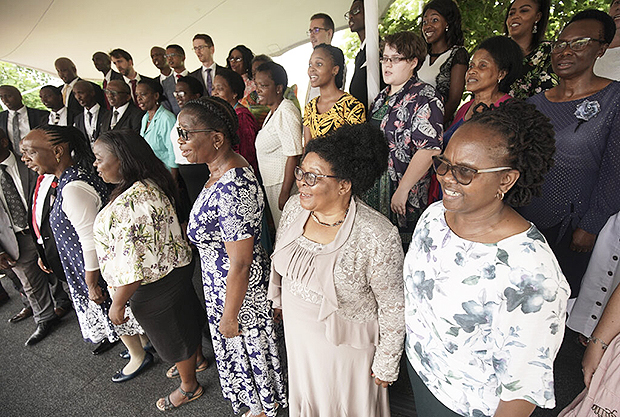
A choir sings during the Durban South Africa Temple dedication cornerstone ceremony in Umhlanga, South Africa, on Sunday, February 16, 2020. Photo by Jeffrey D. Allred, Deseret News.

Elder Ronald A. Rasband of the Quorum of the Twelve Apostles helps his granddaughter Ella Chase with mortar during the cornerstone ceremony for the Durban South Africa Temple dedication in Umhlanga, South Africa, on Sunday, February 16, 2020. Photo by Jeffrey D. Allred, Deseret News.

Agnes Agyapong waits for the next session during the Durban South Africa Temple dedication in Umhlanga, South Africa, on Sunday, February 16, 2020. Photo by Jeffrey D. Allred, Deseret News.

Umbrellas are used to stay cool outside the Durban South Africa Temple on its dedication day in Umhlanga, South Africa, on Sunday, February 16, 2020. Photo by Jeffrey D. Allred, Deseret News.

Umbrellas are used to stay cool outside the Durban South Africa Temple on its dedication day in Umhlanga, South Africa, on Sunday, February 16, 2020. Photo by Jeffrey D. Allred, Deseret News.

A young boy sits on the edge of a water fountain outside the Durban South Africa Temple on its dedication day in Umhlanga, South Africa, on Sunday, February 16, 2020. Photo by Jeffrey D. Allred, Deseret News.
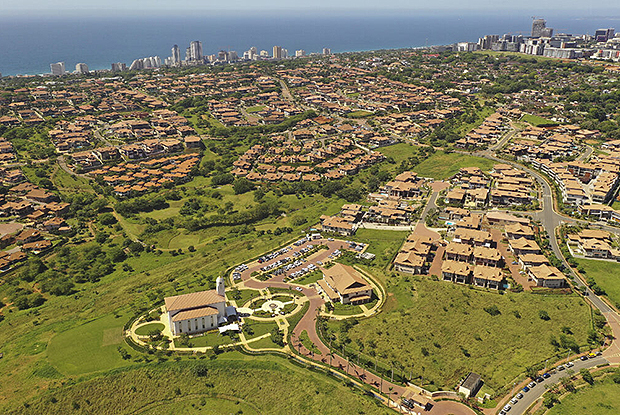
The Durban South Africa Temple sits atop a hill overlooking the Izinga Ridge development in Umhlanga, South Africa, on Sunday, February 16, 2020. Photo by Jeffrey D. Allred, Deseret News.

People leave the Durban South Africa Temple in Umhlanga, South Africa, on Sunday, February 16, 2020. Photo by Jeffrey D. Allred, Deseret News.

A specially made handkerchief for the Durban South Africa Temple dedication in Umhlanga, South Africa, on Sunday, February 16, 2020. Photo by Jeffrey D. Allred, Deseret News.
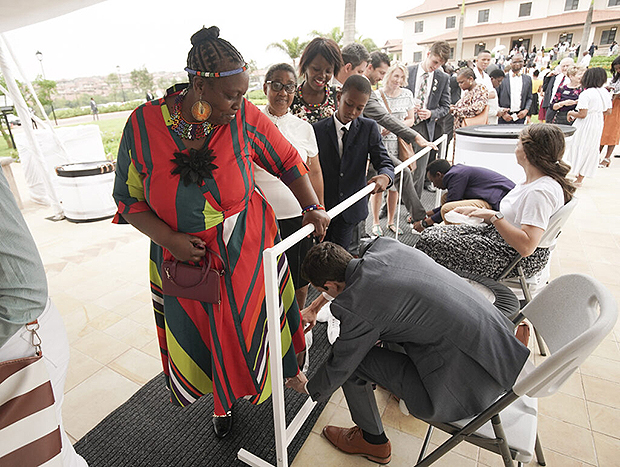
Nhla Dlomo gets shoe coverings placed prior to the Durban South Africa Temple dedication in Umhlanga, South Africa, on Sunday, February 16, 2020. Photo by Jeffrey D. Allred, Deseret News.

Attendees wait for the session during the Durban South Africa Temple dedication in Umhlanga, South Africa, on Sunday, February 16, 2020. Photo by Jeffrey D. Allred, Deseret News.

Attendees wait for the session during the Durban South Africa Temple dedication in Umhlanga, South Africa, on Sunday, February 16, 2020. Photo by Jeffrey D. Allred, Deseret News.

Attendees wait for the session during the Durban South Africa Temple dedication in Umhlanga, South Africa, on Sunday, February 16, 2020. Photo by Jeffrey D. Allred, Deseret News.
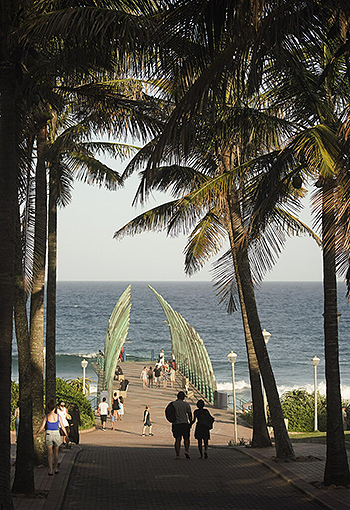
People walk toward the pier in Umhlanga, South Africa, on February 13, 2020. Photo by Jeffrey D. Allred, Deseret News.
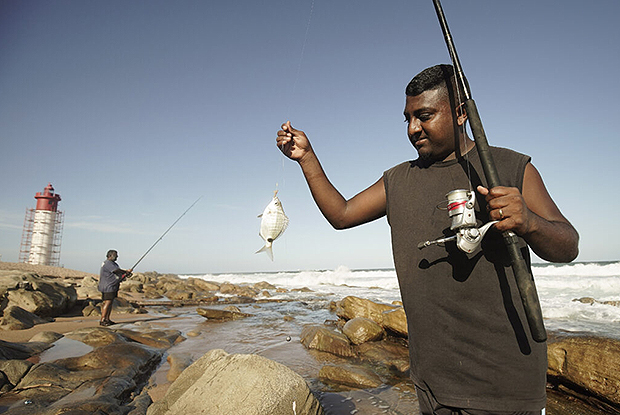
A man catches a fish in Umhlanga, South Africa, on February 13, 2020. Photo by Jeffrey D. Allred, Deseret News.

People walk on the pier in Umhlanga, South Africa, on February 13, 2020. Photo by Jeffrey D. Allred, Deseret News.
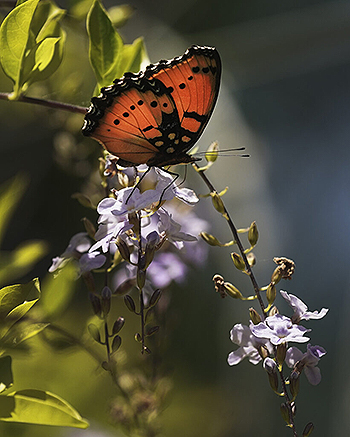
A butterfly in Umlazi, South Africa, on February 14, 2020. Photo by Jeffrey D. Allred, Deseret News.
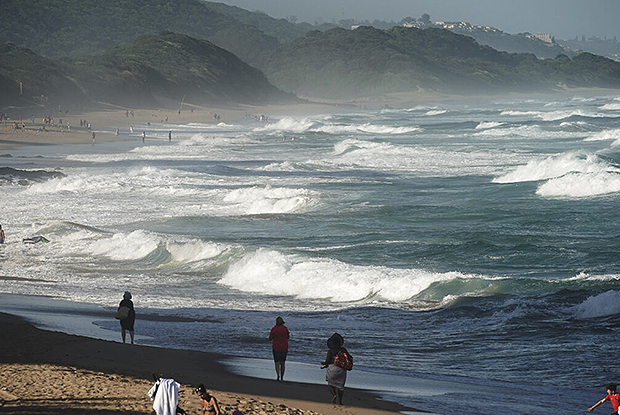
People walk with a view of the Indian Ocean in Umhlanga, South Africa, on February 13, 2020. Photo by Jeffrey D. Allred, Deseret News.
Design: Inspired by the buildings of downtown Durban about 12 miles to the south, the temple features the decorative motifs of the king protea, South Africa’s national flower, both inside and outside, ranging from entry gates and stone benches to the art-glass windows. White fluted stone panels accent window openings, the red clay tile roof pairs with the homes in the neighboring developments, and the region’s Africa roots are seen in wood and carpet carvings inside.
Landscaping: Atop a grassy knoll that was once part of extensive fields of sugar cane, the 14.49-acre property is home to more than 800 trees, ranging from king palms to coral trees. The 2,800 square meters of lawn include thousands of shrubs, vines, and flowers.
Interior: Similar to the exterior, interior walls have recessive steps that result in shadow lines and detailing, while the millwork, casework, and doors are done in sapele mahogany, with diamond patterns used to highlight the wood’s grain. Flooring includes custom-made, imported rugs and Italian marble tiling, with African themes predominant from geometric tribal patterns. Some 50 pieces of art adorn the walls, displaying the ministry of the Savior as well as African landscapes and wildlife and indigenous flora and fauna.
Key Church dates in South Africa and Durban
April 1853: Church missionaries from Utah begin preaching around Cape Town.
1855: Church membership includes 176 converts organized into six congregations.
1863: The first missionary is sent to Durban.
Late 1800s: After many new members emigrate to North America, missionary work ceases.
1903: Missionaries return to South Africa.
1925: First meetinghouse built and dedicated in Johannesburg.
1958: First meetinghouse in Durban.
1970: First stake organized in South Africa, headquartered in Johannesburg.
1978: President Kimball receives revelation that all worthy males 12 and older can be ordained to the priesthood.
1981: First stake organized in Durban.
1984: First known Zulu full-time missionary is called to serve in England.
1985: Johannesburg South Africa Temple is dedicated.
1987: A partial Zulu translation of the Book of Mormon is published. Full translations were later published in Xhosa (2000), Zulu (2003), and Twana (2003).
1992: A new mission is organized in South Africa, headquartered in Durban.
2011: A new temple for Durban, South Africa, is announced by President Thomas S. Monson.
2016: Groundbreaking for the Durban South Africa Temple is held on April 6, presided over by Elder Carl B. Cook, a General Authority Seventy and President of the Africa Southeast Area.
2020: The Durban South Africa Temple is dedicated by Elder Ronald A. Rasband of the Quorum of the Twelve Apostles.
